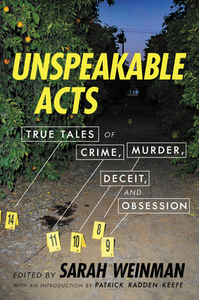Take a photo of a barcode or cover
dark
informative
reflective
sad
medium-paced
This is a collection of long-form nonfiction true crime that makes for a quick read with insights and critiques on interest in the genre.
The only disappointing aspect about this book is that I already knew 90% of the cases, so I didn't really learn anything new. I was hoping to read about some lesser known cases but most of them were pretty popular.
the essays collected here focus on the humanity behind the salacious lens of common “true crime.” the writers ask you to understand the perspectives of both the victims and perpetrators, and the limitations and outright discrimination of the justice system. the collection also covers what we gain and lose through depictions of true crime, and whether the stories we’re told are the right ones. for anyone interested in true crime as entertainment, this is a must read as a reminder of the reality of the genre.
justice for sage smith
justice for sage smith
At last, a worthy successor to Otto Premingers much-loved, much-missed "Best American Crime Writing" series. This is a great anthology, full of stories that are thoughtful, disturbing, yet compulsively readable. Here's hoping the editors get enough success to do this regularly!
dark
informative
slow-paced
challenging
dark
medium-paced
A nonfiction anthology about true crime and all the messy ways it interacts with culture? Count me in.
UNSPEAKABLE ACTS is a compelling read that brings together some of the best true crime writing from the past decade. There are three parts: direct reporting on specific cases, broader pieces going meta on true crime in the media, and finally explorations of true crime in unexpected ways (such as gun violence from the perspective of an ER doctor, and the absurd powers of Customs & Border Control).
While there was an acknowledgment in the introduction about how much true crime focuses on wealthy, white, female victims, I was disappointed that this book mostly reinforced that trend until the last section. Did we really need another meditation on Ted Bundy when I know there are reporters and activists desperately trying to bring attention to black and brown victims?
Overall, this captured my #murderino interests, but I’m still waiting for the true crime anthology that challenges the industry more acutely.
Thank you NetGalley and Ecco Books for providing an eARC in exchange for this review.
UNSPEAKABLE ACTS is a compelling read that brings together some of the best true crime writing from the past decade. There are three parts: direct reporting on specific cases, broader pieces going meta on true crime in the media, and finally explorations of true crime in unexpected ways (such as gun violence from the perspective of an ER doctor, and the absurd powers of Customs & Border Control).
While there was an acknowledgment in the introduction about how much true crime focuses on wealthy, white, female victims, I was disappointed that this book mostly reinforced that trend until the last section. Did we really need another meditation on Ted Bundy when I know there are reporters and activists desperately trying to bring attention to black and brown victims?
Overall, this captured my #murderino interests, but I’m still waiting for the true crime anthology that challenges the industry more acutely.
Thank you NetGalley and Ecco Books for providing an eARC in exchange for this review.
Thanks to NetGalley and Ecco for an ARC of this title.
What a fantastic survey of recent true-crime writing. Sarah Weinman has lined up a murderers row of pieces and authors showcasing the broad ways true-crime articles can highlight cases, discuss cultural phenomena, and speak to larger questions about justice and society. If you're a regular true-crime reader, you've likely encountered many of these pieces before (I was familiar with the opening piece on Dee Dee and Gypsy Rose Blanchard, a piece from the middle section on Slenderman, and Pamela Colloff's explanation on the dubious nature of blood spatter analysis), but it's fantastic to have these all together in one volume, some of these appearing in print (rather than online-only) for the first time.
The book is divided into three sections: "Narrative Features" (which contains four pieces that most closely fit what we think of as capital-T capital-C "True Crime" stories as they appear in print and in podcasts), "Where Crime Meets Culture" (five pieces on how true crime stories have broader cultural implications), and "Justice and Society" (four pieces that take a broader look at how aspects of true crime can lead to a lack of justice for certain parties). Of these three, I think section two is the most effective - there's a stunning piece on Ted Bundy by Sarah Marshall (one of the hosts of the "You're Wrong About" podcast) that I somehow hadn't ready before that questions the nature of what we consider a psychopath, and a fantastic piece from Alice Bolin that dissects what separates "lowbrow" true crime from "highbrow" true crime, and the ethical dilemmas that opens up. The "Justice and Society" section is less effective, partially because of how broad it goes - there are some great pieces, like the aforementioned blood spatter piece and another by Emma Copely Eisenberg asking questions about the way a missing persons/homicide case involving a trans victim was handled vs. a similar case with a white victim, but other pieces don't feel as closely connected to the same type of true crime covered in the rest of the book.
There's an "Other Notable Crime Stores" section at the end of the book that caps it off perfectly, giving the reader plenty of articles and essays, books, podcasts, and media sources to get lost in if the book itself left you hungry for more. All in all, this is a fantastic collection (even if you've read some of these stories before), and it's a great snapshot of the current state of true crime reporting.
What a fantastic survey of recent true-crime writing. Sarah Weinman has lined up a murderers row of pieces and authors showcasing the broad ways true-crime articles can highlight cases, discuss cultural phenomena, and speak to larger questions about justice and society. If you're a regular true-crime reader, you've likely encountered many of these pieces before (I was familiar with the opening piece on Dee Dee and Gypsy Rose Blanchard, a piece from the middle section on Slenderman, and Pamela Colloff's explanation on the dubious nature of blood spatter analysis), but it's fantastic to have these all together in one volume, some of these appearing in print (rather than online-only) for the first time.
The book is divided into three sections: "Narrative Features" (which contains four pieces that most closely fit what we think of as capital-T capital-C "True Crime" stories as they appear in print and in podcasts), "Where Crime Meets Culture" (five pieces on how true crime stories have broader cultural implications), and "Justice and Society" (four pieces that take a broader look at how aspects of true crime can lead to a lack of justice for certain parties). Of these three, I think section two is the most effective - there's a stunning piece on Ted Bundy by Sarah Marshall (one of the hosts of the "You're Wrong About" podcast) that I somehow hadn't ready before that questions the nature of what we consider a psychopath, and a fantastic piece from Alice Bolin that dissects what separates "lowbrow" true crime from "highbrow" true crime, and the ethical dilemmas that opens up. The "Justice and Society" section is less effective, partially because of how broad it goes - there are some great pieces, like the aforementioned blood spatter piece and another by Emma Copely Eisenberg asking questions about the way a missing persons/homicide case involving a trans victim was handled vs. a similar case with a white victim, but other pieces don't feel as closely connected to the same type of true crime covered in the rest of the book.
There's an "Other Notable Crime Stores" section at the end of the book that caps it off perfectly, giving the reader plenty of articles and essays, books, podcasts, and media sources to get lost in if the book itself left you hungry for more. All in all, this is a fantastic collection (even if you've read some of these stories before), and it's a great snapshot of the current state of true crime reporting.
The stories were really interesting and I do want to learn more about some of the cases that were presented. However, the articles chosen were poorly written, lacked substance, and at times were incredibly disjointed and confusing. Found this book severely lacking.







